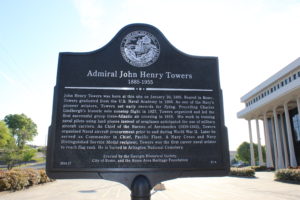This week’s #MarkerMonday shines a spotlight on naval aviator, John Henry Towers. Towers was born January 30, 1885 in Rome, Georgia. After graduating from the US Naval Academy in 1906, Towers went on to have a distinguished career in naval aviation, having entered the program in its early stages. In addition to setting several early flight records, he also organized and led the first successful group trans-Atlantic air crossing May 8-15, 1919. The United States began to develop plans for the trans-Atlantic flight as a way to send supplies to soldiers during World War I by flying to England via the Azores and Spain. Following the Armistice in November 1918, plans for the trans-Atlantic flight went ahead without the added stresses of wartime. Three planes, including one piloted by Towers, embarked on the journey in May 1919. Early in the flight, the planes encountered heavy fog, causing Towers to plan for an emergency landing in the water. Due to damages to the aircraft, Towers was forced to keep his plane afloat for fifty-two hours before repairs could be made in the Azores. In the end, the mission was safely completed. Following this historic flight, Towers‘ naval career saw him serve as the Chief of the Bureau of Aeronautics (1939-1942) and Commander in Chief, Pacific Fleet on the years after World War II. Towers was the first career naval aviator to reach flag rank and a recipient of the Navy Cross, for his involvement in the first group trans-Atlantic flight, and Navy Distinguished Service Medal. He is buried in Arlington National Cemetery.
Explore the links below to learn more about Admiral John Henry Towers.
Images from the dedication of the Admiral John Henry Towers marker can be found on the Greater Rome Chamber of Commerce Facebook page.

